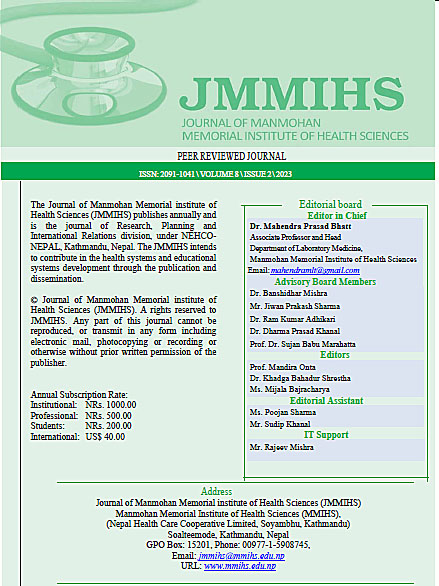Morphological Patterns Of Anemia In Patients With Chronic Kidney Disease In A Tertiary Care Hospital, Nepal
DOI:
https://doi.org/10.3126/jmmihs.v8i2.59751Keywords:
Anemia, Chronic Kidney Disease, Renal replacement therapyAbstract
Introduction: Anemia is the major health issue that is causing the most disability worldwide amongst the patients with chronic kidney disease (CKD). Anemia in CKD is defined as an Hemoglobin level <13.5 g/dl and 12.0 g/dl in men and women respectively as demarcated by National Kidney Foundation. This study provides insights about the subtypes of anemia in patients with chronic kidney disease patients. We aim to determine the morphological Patterns of anemia in a patient with chronic kidney disease, the differential diagnosis of renal anemia.
Methods: A descriptive cross-sectional study was conducted among diagnosed CKD patients presented to the Nephrology Out patient department of a tertiary level hospital in Kathmandu over a six months period, from September 15, 2022 to March 15, 2023. Etiology of anemia were worked out. All adults (>18 years of age) with chronic kidney disease patients with an estimated glomerular filtration rate (eGFR) below 60 ml/min, and who were not started on dialysis were recruited. The study proposal was approved by Institutional review committee (IRC) of Nepalese army institute of health sciences (NAIHS) prior of conducting the study. Convenience Sampling was done.
Result: Anemia was seen in 96.8% of patients among which 58.9% of the patients presented with severe anemia. Among all patients, mean hemoglobin value was 9.45±1.60 g/dl. Moderate anemia was the commonest (50.50%) degree of anemia. Microcytic hypochromic was the commonest (44.7%) finding in peripheral blood film study followed by normocytic normochromic type (43.7%) and plasmacytoma (5.3%).
Conclusion: We found a high prevalence of anemia among chronic kidney disease as compared to other studies conducted in similar settings. The higher percentage of anemia found in the study may be attributed to NKF criteria for anemia diagnosis, the cutoff of which is higher than that for general population. Also, the patients not having received renal replacement therapy in the past were taken in the study, causing higher incidence of anemia in CKD. Treatment of anemia may somewhat improves quality of life. Thus, early recognition and effective treatment in patients with CKD is highly recommended.
Downloads
Downloads
Published
How to Cite
Issue
Section
License
© Journal of Manmohan Memorial Institute of Health Sciences (JMMIHS)
All rights reserved to JMMIHS. Any part of this journal cannot be reproduced, or transmitted in any form including electronic mail, photocopying or recording or otherwise without prior written permission of the publisher.




